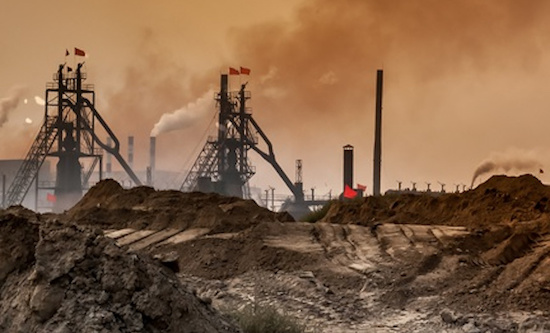
In 1992 China’s outgoing leader Deng Xiaoping stated: ‘The Middle East has oil; China has rare earths’. In this he recognised the key strategic role of rare earths, and China’s potential advantage in the resource wars of the future. Rare earths are a number of similar chemical elements essential for a wide variety of electronics and other commodities. ‘Green’ technologies depend on rare earths, and demand is skyrocketing as economies attempt to ‘transition’ away from fossil fuels. They are also essential for the production of advanced weaponry. US dominance in the rare earths industry in the 1970s and 1980s gave way to a virtual Chinese monopoly by 2000. As the China-US rivalry accelerates, the US is scrabbling to counter the threat this poses by reviving its own rare earths industry, irrespective of the waste and environmental destruction caused.
‘Rare earths’ is a term which refers to seventeen metallic elements: scandium, yttrium and lanthanum, along with the 14 other ‘lanthanides’. Some of the most important are neodymium and praseodymium, which are essential for electronic magnets. Rare earth minerals, rare earth metals and rare earth ores are terms often used without precision to refer to these elements or compounds of them. These elements have become invisibly and inextricably woven into the fabric of modern life. 26% go into glass production, followed by 21% for magnets, 19% for catalysts and 11% for batteries (2017 figures – FT 14 September 2020). Rare earth magnets and rechargeable batteries are essential for most existing ‘green’ technologies. Over 90% of electric and hybrid vehicles use rare earth magnets in their motors, and many wind turbines rely on rare earths. Many consumer electronics use rare earths, including hard disk drives and mobile phones. Europium was essential in the development of colour television, and continues to be used in the production of computer and television screens. Every US F-35 fighter jet needs nearly 200kg of rare earth elements, and advanced missile systems, lasers and drones also require them.
Rare earths are not rare – even the rarest are 200 times more common than gold (The Economist 17 September 2010). They are found in small concentrations all over the world, with about one-third of proven reserves in China – mainly Inner Mongolia. The US, Australia, Brazil, Russia, India, Afghanistan and countries in south-east Asia (notably Vietnam) also have significant reserves. It is predicted that major reserves may be found in southern Africa, Kazakhstan, Canada and Greenland (China’s Global Times mocked Trump’s 2019 proposal to buy Greenland from Denmark as driven by the US’s desire for rare earths). The government of North Korea (DPRK) also claims it has reserves. California’s Mountain Pass mine used to provide most of the world’s supply, with the US also dominant in the whole processing chain from the 1960s to the early 1990s. However, Chinese governments from Deng Xiaoping’s onwards have invested in developing mining, refining and manufacturing. China produced 90% of the world’s rare earths by the late 1990s. The US stopped production in 2003.
Global rare earth oxide production trends – graph and interpretation from US Geological Survey
China’s strategy of developing the higher end of the processing chain, to avoid the ‘resource curse’ of many areas rich in raw materials, has been so successful that in the last two years it imported more unrefined rare earth elements than it exported. Production and export is controlled by a state quota, and changes in this quota have been used to maintain dominance in the industry. Embargos and threatened embargos have been major political weapons. Rare earths shot into the news in July 2020 when China threatened to impose sanctions on US arms company Lockheed Martin (the manufacturer of the F-35) over a deal with Taiwan (which China does not recognise). The US has seen the need to restart extraction and manufacture domestically as rivalry has increased. The Pentagon, eager to secure the resources needed for its obscene supply of military hardware, has funded companies such as MP Minerals and Lynas which are restarting the US rare earths industry. Mountain Pass restarted extraction of unrefined rare earths in 2018. However, the US is yet to restart refining and has had to rely on China to process its unrefined resources. The Trump administration has budgeted $209m to support the sector this year. US processing plants are due to be operational by the end of 2020.
The mining of rare earths involves the extraction of tiny amounts of the sought-after elements from huge areas. This process is wasteful and environmentally damaging but ecological concerns are always trumped by profits. China’s rare earth mining has created lakes of toxic effluent, caused sulphuric acid poisoning (a byproduct of cerium processing) and concentrations of cancer diagnoses (LMD July 2020). The government has faced pressure from local communities and from within the Communist Party to reduce pollution. Environmental damage at Mountain Pass mine contributed to its closure. In a world of capitalist mass consumption rare earths are a throwaway resource like any other – electronics are produced to rapidly become obsolete, whether through design or fashion. Recycling of rare earth elements from waste electronics is possible but is not yet commercially viable. As resources are finite this may change. In a socialist global system of production, where people are put before profits, it may be possible to value and use such resources in ways which are socially and ecological sustainable. However, in an imperialist world there can be no production of rare earths which is sustainable for the Earth and the majority of its people.
Toby Harbertson




